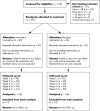Cryotherapy for acute ankle sprains: a randomised controlled study of two different icing protocols
- PMID: 16611722
- PMCID: PMC2579462
- DOI: 10.1136/bjsm.2006.025932
Cryotherapy for acute ankle sprains: a randomised controlled study of two different icing protocols
Abstract
Background: The use of cryotherapy in the management of acute soft tissue injury is largely based on anecdotal evidence. Preliminary evidence suggests that intermittent cryotherapy applications are most effective at reducing tissue temperature to optimal therapeutic levels. However, its efficacy in treating injured human subjects is not yet known.
Objective: To compare the efficacy of an intermittent cryotherapy treatment protocol with a standard cryotherapy treatment protocol in the management of acute ankle sprains.
Subjects: Sportsmen (n = 44) and members of the general public (n = 45) with mild/moderate acute ankle sprains.
Methods: Subjects were randomly allocated, under strictly controlled double blind conditions, to one of two treatment groups: standard ice application (n = 46) or intermittent ice application (n = 43). The mode of cryotherapy was standardised across groups and consisted of melting iced water (0 degrees C) in a standardised pack. Function, pain, and swelling were recorded at baseline and one, two, three, four, and six weeks after injury.
Results: Subjects treated with the intermittent protocol had significantly (p<0.05) less ankle pain on activity than those using a standard 20 minute protocol; however, one week after ankle injury, there were no significant differences between groups in terms of function, swelling, or pain at rest.
Conclusion: Intermittent applications may enhance the therapeutic effect of ice in pain relief after acute soft tissue injury.
Conflict of interest statement
Competing interests: none declared
Comment in
-
Icing protocols for acute ankle sprains.Clin J Sport Med. 2007 Jul;17(4):335. doi: 10.1097/01.jsm.0000277813.25356.fe. Clin J Sport Med. 2007. PMID: 17620801 No abstract available.
References
-
- Garrick J G, Requa R K. The epidemiology of foot and ankle injuries in sports. Clin Podiatr Med Surg 19896629–637. - PubMed
-
- Shrier I. Treatment of lateral collateral ligament sprains of the ankle: a critical appraisal of the literature. Clin J Sport Med 19955187–195. - PubMed
-
- Bleakley C M, McDonough S M, MacAuley D C. The use of ice in the treatment of acute soft tissue injuries. A systematic review of randomized controlled trials. Am J Sports Med 200432251–261. - PubMed
-
- Bleakley C M, MacAuley D C, McDonough S M. How good is ice in the treatment of acute soft tissue injuries? In MacAuley D, Best T, eds. Evidence based sports medicine. 2nd ed. Oxford: Blackwell BMJ books, 2006, in press.
Publication types
MeSH terms
LinkOut - more resources
Full Text Sources
Medical





